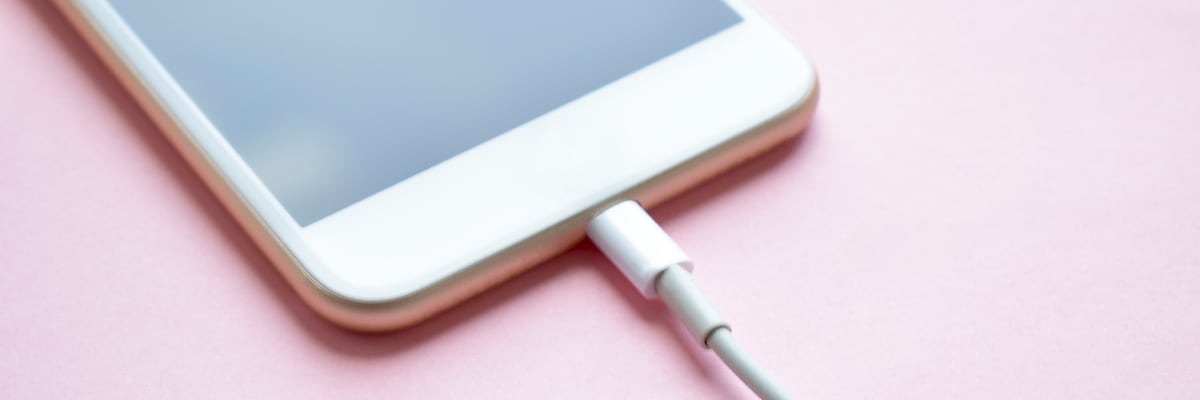
Return navigate_next
Out of Juice? Hacks for Charging Your Phone Faster
September 30, 2021 *
There’s nothing worse than reaching for your phone to take care of a crucial task, only to see that it’s running out of juice. Today’s phones are lucky to last a full day, and the problem is especially bad if you’re using an older smartphone.
If you’re running out of juice faster than you’d like, you need to charge up your phone as quickly as possible. Did you know that not every charger or charging method works equally well?
The truth is, there’s more science (and more options) behind charging a phone than you might expect. Here’s what to do to get your phone charging faster.
Use a Higher Watt Charger
For a long time, the standard USB charger charged at 5 Watts. Those iconic square iPhone chargers and pretty much every early Android charger were the same in this regard. 5 Watts of output was the de facto standard.
But in recent years, devices and chargers alike have gotten smarter and wattage outputs have gotten higher. Apple, for example, started offering 10-Watt chargers with certain iPads and now offers a whole smorgasbord of power adapters at various wattage levels, including a 20-Watt USB-C power adapter and a 30-Watt USB-C power adapter. The 30-Watt is enough to fully charge a MacBook Pro, even.
At least in the Apple ecosystem, any compatible charger at any wattage level will be safe to use with your phone. Things get a little more complicated when you move into third-party chargers, so it’s always best to make sure a charger claims compatibility with your specific device.

Generally, the higher the wattage, the faster the charge. That said, some high-Watt chargers fall into an entirely separate category: Fast Charging.
Use Fast Charging
Fast Charging can mean a wide variety of things, from empty marketing language to real functionality. If you have a phone that supports fast charging, you’ll get charged from zero to 50% quite a bit faster than conventional chargers can do. (Some methods push the fast charging window even higher, too.) The remaining charge level is transmitted at normal levels to avoid damaging your device’s battery.
Unfortunately, you won’t find standardization in fast charging methods, which makes things tricky. Some Android manufacturers are doing their own proprietary stuff here, so make sure you look up what your phone can do (if anything) before you go buying a new charger. You have to be sure you’re getting the right one if you want to get any benefit.
In addition to some proprietary methods, there are two more widely adopted standards for fast charging: Qualcomm Quick Charge and USB Power Delivery (USB PD).
Qualcomm Quick Charge
Qualcomm Quick Charge was the first fast charging standard to gain traction. It wasn’t and isn’t perfect, but it can charge up to 27 Watts and save you plenty of time.

Most of the devices using this standard are older smartphones from Samsung, LG and others. Qualcomm Quick Charge works over USB-A, micro USB and USB-C.
USB Power Delivery
The USB PD standard has the backing of the USB Implementers Forum and can charge up to 100 Watts, faster and much more powerful than Qualcomm’s method. It’s a USB-C based standard, although this is where things get tricky. Not every USB-C cable nor charger is built for USB PD, and there isn’t always an obvious way to tell by looking.
Apple adopted this standard starting with the iPhone 8, and Samsung did the same at the S20 (and S10 5G). Later Google Pixels also supported this standard.
Wired vs. Wireless Charging for Your Phone
In general, wired charging is always going to be faster than wireless. If speed of charging is the priority, go ahead and plug in.
If you’re committed to wireless charging, though, there are still some things you should know. Most wireless chargers (and phones supporting wireless charging) top out at 7.5 or 10 Watts. The newest Qi chargers (and Apple MagSafe wireless chargers) support up to 15 Watts in ideal conditions. These will be far faster (though still slower than plugging in for Fast Charging).

On-Device Tips
Last, here are a few on-device tips for charging faster.
Your phone will charge faster (or at least appear to do so) if you exit to the home screen and power off the screen. In other words, don’t use it while it’s charging. There’s no magic here; you’ll simply avoid taxing the system while charging, which can lead to perceived slowdowns.
Second, if your phone doesn’t seem to charge reliably or drops suddenly in battery reading, you might need to consider getting the battery replaced altogether.
Fast, Slow, Wired, Wireless: Protect Your Phone with Upsie
However you decide to charge your phone, one takeaway remains relevant: you should protect your phone with an extended subscription warranty from Upsie. Upsie covers damage from charging or power surges, in addition to a wide range of other failures, issues, and accidents like spills or broken screens. Coverage is easy to get and easy to use with 24/7 claims. Plus, you get comprehensive coverage for just $9.99 per month.
Learn More About Smartphones:
* This article is over 6 months old and may or may not be updated.
